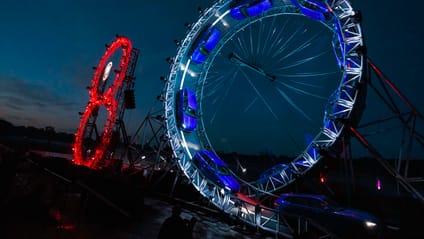
How Jaguar's F-Pace conquered the world's biggest loop-the-loop
How does an SUV perform a 19-metre loop? We go behind-the-scenes to find out


Watching from ground level, the stunt seems oddly… serene. A blue Jaguar F-Pace thumps down the damp approach road, enters the 19-metre loop and gracefully inverts. In near-silence it turns upside down: over, round and through.
All over in, what, three seconds? A strange spectacle, for sure – not to mention a world record for the biggest loop the loop ever – yet curiously tranquil to behold.
But when stunt driver Terry Grant emerges from the F-Pace a few seconds later to chat with compere Martin Brundle, it’s clear things didn’t feel quite so tranquil from the driver’s seat. Terry’s voice is cracking, his words wobbly.
This isn’t what you expect from Mr Grant: the holder of 19 driving world records, the man who’s done more weird, extreme things in cars than anyone else on the planet. If a stunt is out of Terry’s comfort zone, we’re talking – in the immortal words of Sir Alex Ferguson – serious squeaky-bum time.
This feature was originally published in the December 2015 issue of Top Gear magazine.
Advertisement - Page continues below
It started, as the best ideas do, with a kids’ toy. Playing with his child’s Hot Wheels loop, Jaguar global comms boss Rich Agnew wondered if it’d be possible to create a life-sized version to launch the F-Pace. He contacted Terry, because Terry’s the bloke you contact when you want to do something silly with a car.
“Rich gave me this big cheesy grin. I couldn’t say no,” remembers Terry, talking to TopGear after the Frankfurt stunt. He had built and performed loop the loops before, but all had used far smaller and lighter cars than the F-Pace. This one would be much bigger.
Armed with the F-Pace’s vital statistics, Terry went off and chatted to his team of engineers to see if the stunt was physically possible. The initial calculations showed the loop would have to be some 16 metres tall, a vast construction and an order of magnitude bigger than anything he’d attempted before.
Jaguar checked the record books. The existing record was an 18.29-metre double loop, built in 2012 by Hot Wheels and driven by TG USA host Tanner Foust and Greg Tracy. Terry had been involved in the planning and safety for that stunt.

“Jaguar came back and said, ‘What if we go for the biggest loop in the world? The record,’” says Terry. “I thought about it and said, ‘If we can get it built, I’m up for it.’ I contacted Tanner and Greg to check they were OK with it. They’re buddies of mine. Tanner said, ‘Terry, if there’s anyone who deserves to have the record, it’s you, not two wise-arses from California.’”
It was decided. The F-Pace loop would stand 19.08 metres tall, giving clear air between Jaguar and the previous record. The engineers’ calculations suggested that, with ballast, the structure would weigh 102 tonnes. A team of 60 builders got to work.
Advertisement - Page continues below
As the ramp was being constructed, so were two custom F-Paces. “It’s the first time a car of this type had been used for a loop,” explains Terry. “All the other cars doing the loop the loop are purpose-built. We were attempting something that had never been done before.”
The biggest challenge was the suspension. As the F-Pace hit the loop, a 6.5g load would drive straight through its wheels into the body. Safety regulations dictate road cars’ links and wishbones are designed to collapse in a 5g accident, so every suspension component on the F-Pace had to be removed, reinforced and refitted.
“We needed the whole thing to squat, and stay squatted all the way though the loop,” remembers Terry. “If the car had bounced back on its suspension, it would have jumped off the loop [usually, cars built to do loops have solid suspension] so we had to block the suspension out.”

The modified F-Paces were to look stock from the outside, but underneath had full, purpose-built roll cages. “The worksmanship was amazing,” says Terry. “They looked like touring cars on the inside.” The tyres were inflated to a bulging 80psi to stop them deforming under the g-force.
The next question was: just how fast would an F-Pace need to travel to get around a 19-metre loop without plummeting to the ground? Turns out that’s not a straightforward question to answer. Many sketches were made and equations devised, and it was calculated that Terry’s optimum entry speed was 51mph. “They said at 49mph you’ll be OK, but you don’t want to be going more than 56.”
There would be no margin for error. A fraction too slow and the car wouldn’t have enough speed to complete the loop and would fall off at the top. Go in too hot, and the g-force would cause the F-Pace to ground out on the ramp, losing speed, and also potentially cause Terry to black out.

To practise the stunt, Terry sourced a 10-metre loop used in an old Shell stunt, and had it installed at RAF Bentwaters, where the new mega-loop was also being constructed. In the weeks leading up to tackling the record-breaking loop, Terry ran the smaller one more than 50 times, with brutal physical consequences.
“It makes you feel horrendous. It’s all the blood rushing to your head. The first few times I did it, I was peeing blood,” grins Terry. “All your organs are getting rattled around. You have to train your body, train your mind. It’s like a weightlifter doing a jerk.” He embarked on a rigorous training and diet regime to ensure he could survive the loop.
He was also effectively driving one-handed: a couple of weeks before, he’d sustained an injury when a barrel-roll stunt went wrong, pinning his right hand between the top of the steering wheel and the collapsed roof of the car.
“I’d f***ed up my hand in a big way,” he remembers. “I broke two bones but took the option not to get it repaired. It would have put me out of action to do the loop.”

D-Day came two weeks before the stunt. That was the day Terry and the F-Pace would run the 19m loop for the first time at Bentwaters. If they could do it there, the stunt itself would be fine.
“We knew the magic number was 51.5mph,” says Terry. “Flat-out in second, the F-Pace would do 53mph. Perfect. Get the car in second gear, mash it, keep my foot in.”
What could go wrong? Quite a lot, potentially. The team calculated a 265-metre runway would give the F-Pace time to get up to speed, with three seconds to spare to make sure Terry had time to conduct his pre-flight checks.
“If my foot slipped off the pedal when upside down, we’d fall off the loop. So I had a hand throttle in my left hand. Before I hit the loop, I had to push the hand throttle on, get back on the steering wheel, check the speedo, get my line right. The track wasn’t much wider than the car, so I needed my A-game.”
Advertisement - Page continues below
As Terry’s team assembled for the briefing at Bentwaters, nerves were jangling. “The safety guys were really worried. If I was upside down, or on fire, whatever, how were they going to revive me?” says Terry. “I just climbed onto something and said: ‘For f**k’s sake, we’re going to set a record. I’m going to be fine.’ Everyone started smiling. You could see them thinking, ‘Who is this prick?’ In a nice way. I said, ‘Guys, we’re going to do this. I’m not going to take the escape road.’”

At the end of the runway, Terry strapped in. “I said, ‘I’m ready, let’s do it.’ First, second, 53mph. Perfect. I said to them on the radio, ‘I’m going in.’”
A gang of 100 engineers held their breath. So did Terry. The F-Pace inverted into the unknown.
“Done. Straight through,” says Terry. “I remember them screaming at me on the radio, they knew I’d done it. I came out of the loop, turned around, then drove back to where everyone was. I climbed on top of the car, raised my arm in the air. For that second I was a hero. Then I put my foot on the button that set the fire extinguishers off…”
Advertisement - Page continues below
Practice over, all that was left to do was simply dismantle the ramp, ship it and the cars over to Frankfurt, reconstruct the whole thing and perform the stunt again. This time in front of the world’s media.
The plan was perfect, apart from the fact it poured with rain before the stunt, requiring the team to completely repaint the ramp with grippier paint. And extend the runway by 80 metres – using makeshift wood, pallets, anything they could find – to make sure the F-Pace could get up to speed on the sopping surface.
“The thing was wheelspinning the whole way down the runway,” says Terry of the final, televised stunt. “And when the car was completely upside down, I was doing 15mph but the speedo went up to 50mph. I was getting wheelspin because the wheels left the ground. That’s how close we were.”

Does that explain the emotion, the cracking voice in his post-loop interview? “No, I was calm. The emotions were there because I hadn’t let down everyone involved, everyone who’d worked so hard. Everything hit me at once. It’s the biggest stunt I’ve ever done. What do you do next?”
What indeed? Probably a few more loops: with the vast structure slated for destruction after its stunt, Terry convinced Jaguar to let him buy it, to be shipped back to Britain piece by piece.
“I don’t have a plan for it yet,” he admits. “But I couldn’t let it go to the scrapheap in Frankfurt…”







